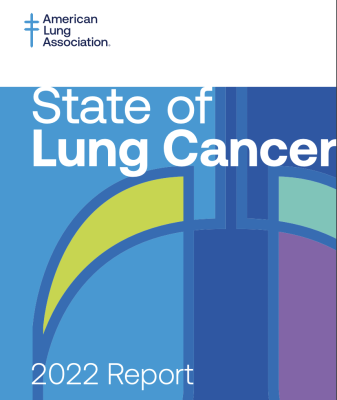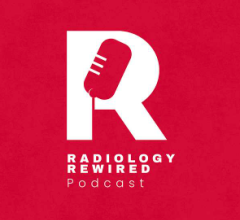
The American Lung Association's 2022 “State of Lung Cancer” report examines key indicators throughout the U.S. including new cases, survival, early diagnosis, surgical treatment, lack of treatment and screening rates. Photo credit: American Lung Association
November 15, 2022 — A newly-released American Lung Association (ALA) report highlights how the toll of lung cancer varies by state, and examines key indicators throughout the U.S. including new cases, survival, early diagnosis, surgical treatment, lack of treatment and screening rates. The ALA 2022 “State of Lung Cancer” Report explores the lung cancer burden among racial and ethnic minority groups at the national and state levels. In addition to lower survival rates, people of color who are diagnosed with lung cancer face worse outcomes compared to white Americans: they are less likely to be diagnosed early, less likely to receive surgical treatment, and more likely to not receive any treatment.
The comprehensive, action-focused 2022 “State of Lung Cancer” report shows that only 5.8% of eligible Americans have been screened for lung cancer, and some states have screening rates as low as 1%. The best state in the country for lung cancer screening was Massachusetts at 16.3%. Some states, such as California and Nevada, had screening rates as low as 1.0% and 1.3%, respectively.
This year’s report also examines the lifesaving potential of lung cancer screening with a clear message: lung cancer screening is key to early diagnosis, and early diagnosis saves lives. It reinforces that screening can detect the disease at an earlier stage when it’s more curable, and the importance of advancements in lung cancer research which holds the promise for better treatment options.
“While lung cancer screening remains underutilized, our new report revealed continued progress for lung cancer survival. The lung cancer five-year survival rate is now 25% and increased 21% from 2014 to 2018,” said Harold Wimmer, National President and CEO for the American Lung Association. Wimmer added, “Increased lung cancer survival is attributable to advancements in research, better treatments and other factors, however, lung cancer screening is the most immediate opportunity we have to save lives.” He urged persons eligible for lung cancer screening to speak with their doctor about it, noting that if a loved one is eligible, they, too, should be encouraged to get screened.
Based on new research, in March 2021, the United States Preventive Services Task Force (USPSTF) expanded its recommendation for screening to include a larger age range and more current and former smokers. This dramatically increased the number of women and Black Americans who are considered at high risk for lung cancer.
Close to 237,000 people in the U.S. will be diagnosed with lung cancer this year. According to the report, every day, lung cancer takes the lives more than 356 of our friends, neighbors and loved ones. Currently, 14.2 million Americans meet those screening guidelines, under which a person is eligible for lung cancer screening if they are between 50-80 years of age, have a 20 pack-year history (1 pack/day for 20 years, 2 packs/day for 10 years), and are a current smoker, or have quit within the last 15 years. Individuals can find out if they are eligible for lung cancer screening through Saved by the Scan, a comprehensive ALA program.
National Trends in Focus
The 2022 “State of Lung Cancer” report found the following national trends in survival rates, early diagnosis, and treatment of the disease:
- Survival Rate: Lung cancer has one of the lowest five-year survival rates because cases are often diagnosed at later stages, when it is less likely to be curable. The national average of people alive five years after a lung cancer diagnosis is 25%. Survival rates were the best in Rhode Island at 30.8%, while Oklahoma ranked worst at 19.7%.
- Early Diagnosis: Nationally, only 25.8% of cases are diagnosed at an early stage when the five-year survival rate is much higher (61%). Unfortunately, 44% of cases are not caught until a late stage when the survival rate is only 7%. Early diagnosis rates were best in Massachusetts (31.9%), and worst in Hawaii (19.5%).
- Lung Cancer Screening: Lung cancer screening with annual low-dose CT scans for those at high risk can reduce the lung cancer death rate by up to 20%. Nationally, only 5.8% of those at high risk were screened. Massachusetts has the highest screening rate at 16.3%, while California has the lowest at 1.0%.
- Surgery as First Course of Treatment: Lung cancer can often be treated with surgery if it is diagnosed at an early stage and has not spread. Nationally, 20.8% of cases underwent surgery.
- Lack of Treatment: There are multiple reasons why patients may not receive treatment after diagnosis. Some of these reasons may be unavoidable, but no one should go untreated because of lack of provider or patient knowledge, stigma associated with lung cancer, fatalism after diagnosis or cost of treatment. Nationally, 20.6% of cases receive no treatment.
- Health Disparities: The report also highlights that people of color who are diagnosed with lung cancer face worse outcomes compared to white Americans, including lower survival rate, less likely to be diagnosed early, less likely to receive surgical treatment and more likely to receive no treatment.
- Medicaid Coverage: Fee-for-service state Medicaid programs are one of the only healthcare payers not required to cover lung cancer screening for high-risk populations.
Additionally, the ALA analyzed lung cancer screening coverage policies in state Medicaid fee-for-service programs to assess the current status of lung cancer screening coverage for the Medicaid population and found that 46 states’ Medicaid fee-for-service programs cover lung cancer screening, three programs do not provide coverage, and one state did not have information available on their coverage policy.
For the third consecutive year, the “State of Lung Cancer” report explored the lung cancer burden among racial and ethnic minority groups at the national and state levels. In addition to lower survival rates, people of color who are diagnosed with lung cancer face worse outcomes compared to white Americans: they are less likely to be diagnosed early, less likely to receive surgical treatment, and more likely to not receive any treatment.
The “State of Lung Cancer” report provides a state-specific understanding of the burden of lung cancer and opportunities to address this deadly disease. It does not reflect the potential impact of the COVID-19 pandemic on cancer diagnosis, treatment, or survival as the data in the report preceded the emergence of the novel coronavirus.
ALA Outreach and Impact
The report summary issued guidance for the radiology community, physicians and patients impacted by the findings:
"While we have seen advances in personalized treatment thanks to biomarker testing, targeted therapy and immunotherapy, and saved more lives through the introduction of lung cancer screening, the burden of lung cancer is not the same everywhere. Treatment, exposure to risk factors, and use and coverage of screening vary from state to state. To save more lives, it’s critical to prevent lung cancer when possible and diagnose the disease as early as possible. Additionally, everyone should have access to therapies that may extend or improve the quality of their life. By better understanding the impact of lung cancer at the state level, we can encourage interventions to save and extend lives. Our policymakers must do more to protect and expand quality and affordable healthcare coverage and improve access to lung cancer screening and treatment."
A strategic imperative of the American Lung Association is to defeat lung cancer. To that end, it employs a variety of tactics and stakeholders to address the disease and its risk factors, including public policy efforts and public health protections, awareness of lung cancer screening and more. The work of the American Lung Association is focused on four strategic imperatives: to defeat lung cancer; to champion clean air for all; to improve the quality of life for those with lung disease and their families; and to create a tobacco-free future.
A news release on the report issued by the ALA noted that it serves as both a guidepost and rallying call, providing policymakers, researchers, healthcare practitioners, as well as patients, caregivers and others committed to ending lung cancer by identifying where their state can best focus its resources to decrease the toll of lung cancer. Its conclusion states: As the American Lung Association works toward defeating lung cancer, the goal of the “State of Lung Cancer” report is to empower the public to learn more about lung cancer in their state and urge individuals to take action to increase lung cancer screening for individuals at high risk through the Biden Administration's Cancer Moonshot Initiative. Further, it notes that the comprehensive report provides unique information for federal and state officials, policymakers, researchers and those affected by lung cancer and emphasizes the need for resources and action to decrease the toll of lung cancer across the country.
The impact of new guidelines, findings from related research, and background on nationwide initiatives are the focus of an ongoing series published, in print and online (see related coverage), by Imaging Technology News (ITN). Additional highlights of the ALA "State of Lung Cancer" report will be included in the third special report published on the topic in its January/February 2023 issue.
For more information: Lung.org
Related Coverage:
Special Report on Lung Cancer and Screening Initiatives
Special Report on Lung Cancer and Screening Initiatives, Part II


 December 10, 2025
December 10, 2025 









